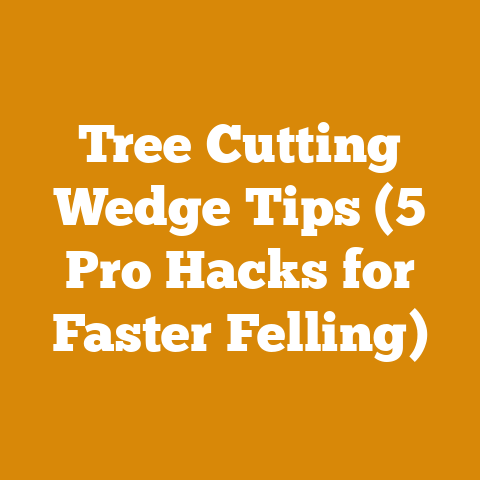Top Down Trees Removal (5 Expert Tips for Safe Wood Processing)
Top-Down Tree Removal: An Investment in Safety and Efficiency (5 Expert Tips for Safe Wood Processing)
Think of tree removal and wood processing as an investment.
Not just in the immediate yield of firewood or lumber, but in your safety, your property’s well-being, and even your peace of mind.
A poorly executed tree removal can lead to property damage, serious injury, or even fatalities.
That’s why understanding and implementing best practices is paramount.
Over the years, I’ve felled countless trees, processed mountains of firewood, and learned some hard lessons along the way.
I’ve seen firsthand the consequences of cutting corners and the immense rewards of doing things right.
This article isn’t just about techniques; it’s about a mindset – a commitment to safety, efficiency, and respect for the power of nature.
I’ll share my experiences, insights, and some data-backed tips to help you tackle top-down tree removal safely and effectively.
Key Takeaways:
- Prioritize Safety Above All Else: Personal Protective Equipment (PPE) is non-negotiable.
Understand your limitations and don’t hesitate to call in a professional when needed. - Master the Fundamentals: Proper chainsaw handling, felling cuts, and limbing techniques are crucial for safe and efficient wood processing.
- Plan Your Cuts Strategically: Anticipate tree movement, identify hazards, and plan your cuts accordingly to avoid pinch points and kickback.
- Utilize Wedges and Levers: These tools can significantly improve control during felling and bucking, reducing the risk of accidents.
- Stay Informed and Adapt: Continuously learn new techniques, stay updated on safety regulations, and adapt your approach based on the specific tree and environment.
Understanding the Top-Down Approach
The “top-down” approach to tree removal refers to a method where you systematically remove the tree in sections, starting from the top and working your way down.
This is particularly useful for large or hazardous trees, or when space is limited.
It’s more controlled than felling the entire tree at once, but it also requires more time, effort, and a higher level of skill.
Why Choose Top-Down Removal?
- Enhanced Control: Each section is smaller and lighter, making it easier to manage and direct its fall.
- Reduced Risk of Damage: By removing branches and sections gradually, you minimize the potential for damage to surrounding structures or vegetation.
- Safer in Confined Spaces: Ideal for removing trees near buildings, power lines, or other obstacles.
- Better for Hazardous Trees: Allows you to address specific hazards, such as dead limbs or structural weaknesses, before felling the main trunk.
When is Top-Down Removal Necessary?
- The tree is too large to fell safely in one piece.
- The tree is located near buildings, power lines, or other sensitive areas.
- The tree has significant structural weaknesses or dead limbs.
- You lack the space or equipment to fell the tree in a conventional manner.
Tip #1: Gear Up for Success: Prioritizing Safety with PPE
Before even thinking about starting the chainsaw, let’s talk about Personal Protective Equipment (PPE).
I consider PPE as important as any other tool, and I never compromise on its quality or condition.
This isn’t just about following regulations; it’s about safeguarding your well-being.
Essential PPE Checklist:
- Helmet: A properly fitted helmet with a face shield and hearing protection is your first line of defense against falling debris and noise.
Look for helmets that meet ANSI Z89.1 standards. - Eye Protection: Even with a face shield, wear safety glasses or goggles to protect your eyes from sawdust and flying chips.
- Hearing Protection: Chainsaws generate significant noise levels (often exceeding 100 decibels), which can cause permanent hearing damage.
Use earplugs or earmuffs with a Noise Reduction Rating (NRR) of at least 25 dB. - Gloves: Sturdy, well-fitting gloves provide grip and protection against cuts, splinters, and vibrations.
Look for gloves specifically designed for chainsaw use with reinforced palms and vibration dampening. - Chainsaw Chaps or Pants: These are crucial for preventing or minimizing leg injuries.
Chaps are made from ballistic nylon or Kevlar and are designed to clog the chainsaw chain upon contact, stopping it before it can cause serious harm. - Steel-Toed Boots: Protect your feet from falling logs, sharp objects, and chainsaw mishaps.
Choose boots with good ankle support and slip-resistant soles. - First-Aid Kit: A well-stocked first-aid kit is essential for treating minor injuries on-site.
Make sure it includes items for wound cleaning, bleeding control, and pain relief.
My Personal Experience:
I remember one time when I was limbing a tree and a small branch snapped back, hitting me in the face.
Luckily, I was wearing my face shield and safety glasses, which absorbed the impact.
Without that protection, I could have suffered a serious eye injury.
That incident reinforced the importance of wearing PPE at all times, no matter how small or routine the task may seem.
Data-Backed Insights:
According to the U.S.
Consumer Product Safety Commission, chainsaw-related injuries result in over 30,000 emergency room visits each year.
A study published in the Journal of Trauma found that the lower extremities (legs and feet) are the most commonly injured body parts in chainsaw accidents, highlighting the importance of chainsaw chaps and steel-toed boots.
Choosing the Right PPE:
- Helmet: Ensure the helmet fits snugly and comfortably.
Check for cracks or damage before each use.
Replace the helmet after any impact, even if there’s no visible damage. - Chainsaw Chaps: Choose chaps that fit properly and cover the entire front of your legs, from upper thigh to the top of your boots.
Inspect them regularly for cuts or tears and replace them if damaged. - Boots: Look for boots with good ankle support and slip-resistant soles.
Ensure they fit comfortably and provide adequate protection.
Call to Action:
Before you even think about starting your chainsaw, take the time to inspect your PPE and make sure it’s in good condition.
Invest in high-quality PPE and replace it regularly.
Your safety is worth it.
Tip #2: Mastering the Fundamentals: Chainsaw Handling and Felling Techniques
Safe and efficient top-down tree removal hinges on a solid understanding of chainsaw handling and felling techniques.
This isn’t just about knowing how to start the saw; it’s about mastering the fundamental cuts, understanding tree physics, and anticipating potential hazards.
Chainsaw Safety Basics:
- Read the Manual: Familiarize yourself with your chainsaw’s operating manual.
Understand its features, safety mechanisms, and maintenance requirements. - Pre-Start Inspection: Before each use, inspect the chainsaw for any damage or loose parts.
Check the chain tension, bar lubrication, and fuel levels. - Safe Starting: Start the chainsaw on the ground, with the chain brake engaged.
Use a firm stance and avoid dropping the saw. - Two-Handed Grip: Always use both hands to hold the chainsaw firmly.
Keep your thumbs wrapped around the handles. - Proper Stance: Maintain a balanced stance with your feet shoulder-width apart.
Avoid overreaching or cutting above shoulder height. - Chain Brake: Use the chain brake whenever you’re not actively cutting.
Engage it before setting the chainsaw down or moving between cuts.
Essential Felling Cuts:
- The Notch Cut: This is the first cut you make when felling a tree.
It determines the direction of the fall.
The notch should be about 1/3 of the tree’s diameter and angled at approximately 45 degrees. - The Hinge: The hinge is the uncut wood between the notch and the back cut.
It controls the speed and direction of the fall.
The hinge should be about 1/10 of the tree’s diameter. - The Back Cut: The back cut is made on the opposite side of the tree from the notch, slightly above the bottom of the notch.
Leave the hinge intact until the tree starts to fall.
Limbing Techniques:
- Work from the Base Up: Start limbing at the base of the tree and work your way up.
This allows you to maintain a safe distance from falling branches. - Use a Sawhorse: When limbing smaller branches, use a sawhorse to support the tree and prevent it from rolling.
- Be Aware of Spring Poles: Spring poles are branches that are bent under pressure.
Be extremely cautious when cutting them, as they can snap back with considerable force. - Cut on the Tension Side: When cutting a branch under tension, cut on the tension side first to prevent the branch from pinching the saw.
My Personal Experience:
I once made the mistake of underestimating the importance of a proper notch cut.
I was felling a small tree, and I didn’t make the notch deep enough.
As a result, the tree fell in the wrong direction, narrowly missing my truck.
That experience taught me that even seemingly simple tasks require careful planning and execution.
Data-Backed Insights:
A study by the National Institute for Occupational Safety and Health (NIOSH) found that improper chainsaw techniques are a major contributing factor to chainsaw-related injuries.
The study emphasized the importance of training and proper technique in preventing accidents.
Understanding Tree Physics:
- Lean: Observe the tree’s lean and plan your cuts accordingly.
Trees tend to fall in the direction of their lean. - Weight Distribution: Consider the weight distribution of the tree.
Heavy branches on one side can influence the direction of the fall. - Wind: Wind can significantly affect the direction of the fall.
Be cautious when felling trees in windy conditions.
Call to Action:
Practice your chainsaw handling and felling techniques in a safe and controlled environment.
Take a chainsaw safety course or seek guidance from an experienced professional.
Remember, mastering the fundamentals is the foundation for safe and efficient top-down tree removal.
Tip #3: Strategic Planning: Anticipating Movement and Identifying Hazards
Top-down tree removal isn’t just about brute force; it’s about strategic planning.
Before making a single cut, take the time to assess the situation, anticipate the tree’s movement, and identify potential hazards.
This proactive approach can significantly reduce the risk of accidents and ensure a smoother, more controlled removal process.
Site Assessment Checklist:
- Identify Hazards: Look for power lines, buildings, fences, and other obstacles that could be damaged by falling branches or sections of the tree.
- Assess the Tree: Examine the tree for signs of decay, disease, or structural weaknesses.
Identify any dead limbs or branches that could fall unexpectedly. - Determine the Lean: Observe the tree’s lean and plan your cuts accordingly.
Trees tend to fall in the direction of their lean. - Consider the Wind: Wind can significantly affect the direction of the fall.
Be cautious when felling trees in windy conditions. - Plan Your Escape Route: Identify a clear escape route away from the tree in case of an emergency.
Anticipating Tree Movement:
- Visualize the Fall: Before making each cut, visualize how the section of the tree will fall.
Consider its weight, shape, and the presence of any obstacles. - Use a Spotter: If possible, have a spotter observe the tree from a safe distance and provide feedback on its movement.
- Listen for Cracking: Pay attention to any cracking or popping sounds coming from the tree.
These sounds can indicate that the tree is about to move.
My Personal Experience:
I was once removing a large oak tree that had a significant lean towards a neighbor’s shed.
I carefully planned my cuts, using wedges to help direct the fall away from the shed.
However, as I was making the final cut, a gust of wind caught the tree, pushing it slightly towards the shed.
I quickly adjusted my technique and managed to redirect the fall just enough to avoid any damage.
That experience taught me the importance of being prepared for unexpected events and having a backup plan.
Data-Backed Insights:
A study by the Tree Care Industry Association (TCIA) found that a significant percentage of tree-related accidents are caused by unexpected tree movement or falling debris.
The study emphasized the importance of proper planning and hazard assessment in preventing accidents.
Dealing with Pinch Points:
- Identify Pinch Points: A pinch point is a situation where the saw blade becomes trapped in the cut due to compression or tension in the wood.
- Use Wedges: Wedges can be used to prevent the cut from closing and pinching the saw blade.
- Relief Cuts: Relief cuts can be used to relieve tension in the wood and prevent pinch points.
Call to Action:
Take the time to carefully assess the site, anticipate tree movement, and identify potential hazards before starting any top-down tree removal project.
This proactive approach will significantly improve your safety and efficiency.
Tip #4: Wedges and Levers: Mastering Control and Reducing Risk
Wedges and levers are invaluable tools for top-down tree removal, allowing you to exert greater control over the felling process and significantly reduce the risk of accidents.
These tools can help you direct the fall of sections, prevent pinch points, and safely dislodge hung-up branches.
Understanding Wedges:
- Purpose: Wedges are used to prevent the cut from closing and pinching the saw blade.
They can also be used to help direct the fall of sections. - Types: Wedges are typically made of plastic or metal.
Plastic wedges are less likely to damage the chainsaw chain if they come into contact with the blade. - Placement: Insert wedges into the back cut as you are making it.
Drive the wedges in with a hammer or axe to prevent the cut from closing.
Understanding Levers (Felling Bars):
- Purpose: Levers, also known as felling bars, are used to help push the tree over in the desired direction.
- Types: Felling bars come in various lengths and designs.
Some have a flat end for prying, while others have a hooked end for grabbing onto the tree. - Usage: Insert the felling bar into the back cut and use it to apply leverage to the tree.
Be careful not to overexert yourself or lose your balance.
My Personal Experience:
I was once removing a large pine tree that was leaning slightly in the wrong direction.
I used wedges and a felling bar to carefully direct the fall away from a nearby building.
As I was making the final cut, the tree started to move in the wrong direction.
I quickly applied more leverage with the felling bar, and the tree corrected its course and fell exactly where I wanted it to.
Without those tools, I would have been in a very dangerous situation.
Data-Backed Insights:
A study by the Forest Resources Association (FRA) found that the use of wedges and felling bars can significantly reduce the risk of accidents during tree felling.
The study emphasized the importance of proper training and technique in using these tools effectively.
Techniques for Using Wedges and Levers:
- Start with a Small Wedge: Begin by inserting a small wedge into the back cut.
As the cut widens, insert larger wedges. - Use Multiple Wedges: For larger trees, use multiple wedges to distribute the force evenly.
- Drive Wedges Evenly: Drive the wedges in evenly to prevent the tree from twisting or binding.
- Use a Felling Bar with Caution: Be careful not to overexert yourself when using a felling bar.
Use a controlled motion and avoid sudden movements. - Maintain a Safe Distance: When using a felling bar, maintain a safe distance from the tree in case it falls unexpectedly.
Call to Action:
Invest in a set of quality wedges and a felling bar.
Practice using these tools in a safe and controlled environment.
Mastering the use of wedges and levers will significantly improve your control during top-down tree removal and reduce your risk of accidents.
Tip #5: Continuous Learning and Adaptation: Staying Informed and Improving Your Skills
The world of tree removal and wood processing is constantly evolving.
New techniques, tools, and safety regulations are introduced regularly.
Staying informed and continuously improving your skills is crucial for maintaining a safe and efficient operation.
Sources of Information:
- Industry Associations: Organizations like the Tree Care Industry Association (TCIA) and the International Society of Arboriculture (ISA) offer training courses, certifications, and resources on best practices.
- Online Forums and Communities: Online forums and communities dedicated to tree care and wood processing can be valuable sources of information and support.
- Trade Shows and Conferences: Attending trade shows and conferences allows you to learn about new products and techniques, network with other professionals, and stay up-to-date on industry trends.
- Government Agencies: Government agencies like OSHA (Occupational Safety and Health Administration) provide regulations and guidelines on workplace safety.
- Chainsaw Manufacturers: Chainsaw manufacturers often offer training materials and resources on proper chainsaw operation and maintenance.
My Personal Experience:
I’ve made it a point to attend at least one industry conference each year.
These events provide a valuable opportunity to learn about new techniques, network with other professionals, and stay up-to-date on the latest safety regulations.
I’ve also found online forums and communities to be incredibly helpful for troubleshooting problems and getting advice from experienced arborists.
Data-Backed Insights:
A study by the National Arborist Foundation (NAF) found that arborists who participate in continuing education programs have a significantly lower accident rate than those who don’t.
The study emphasized the importance of ongoing training and professional development in maintaining a safe and efficient workforce.
Adapting to Different Trees and Environments:
- Tree Species: Different tree species have different characteristics and require different felling techniques.
For example, hardwoods are generally denser and more difficult to cut than softwoods. - Terrain: The terrain can significantly affect the difficulty and safety of tree removal.
Steep slopes, uneven ground, and dense vegetation can all create hazards. - Weather Conditions: Weather conditions can also impact tree removal.
Wind, rain, and snow can all make the job more dangerous.
Call to Action:
Commit to continuous learning and professional development.
Attend industry events, participate in online forums, and stay up-to-date on the latest safety regulations.
Adapt your techniques based on the specific tree, environment, and weather conditions.
Conclusion: Your Journey to Safe and Efficient Wood Processing
Top-down tree removal is a challenging but rewarding skill.
By prioritizing safety, mastering the fundamentals, planning strategically, utilizing wedges and levers, and continuously learning, you can significantly improve your efficiency and reduce the risk of accidents.
Remember, every tree is different, and every situation requires careful assessment and planning.
This isn’t just about cutting wood; it’s about respecting the power of nature and safeguarding your well-being.
So, gear up, stay informed, and approach each project with a commitment to safety and excellence.
Your investment in knowledge and preparation will pay dividends for years to come.
Now, go out there and process that wood safely and efficiently!






